#chinese culture relics
Photo
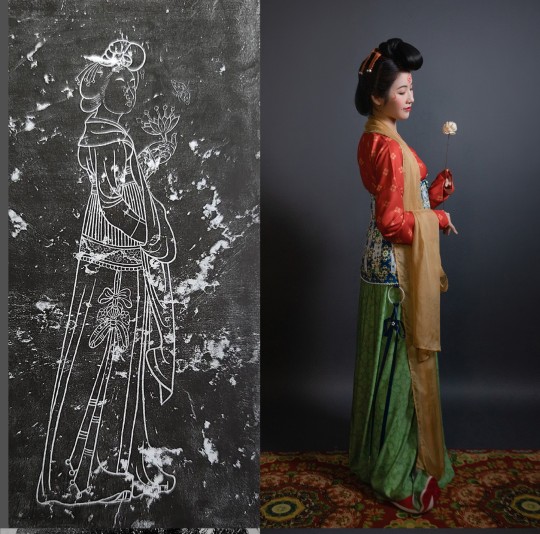

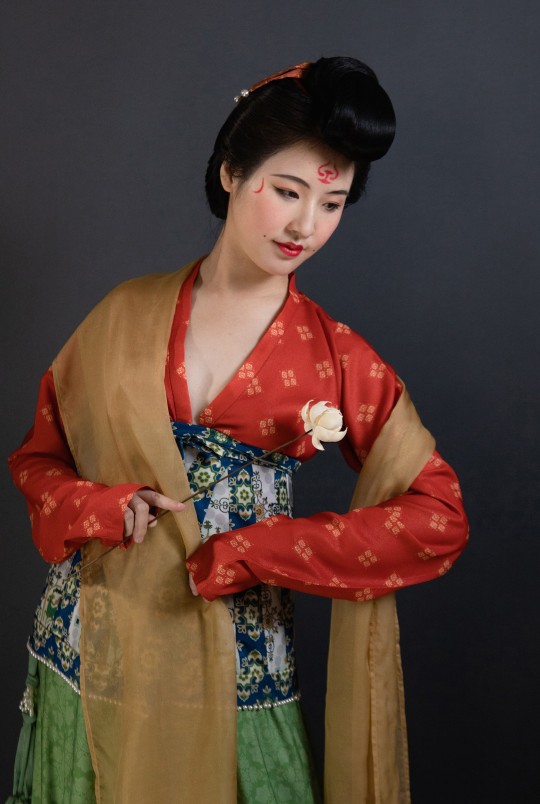
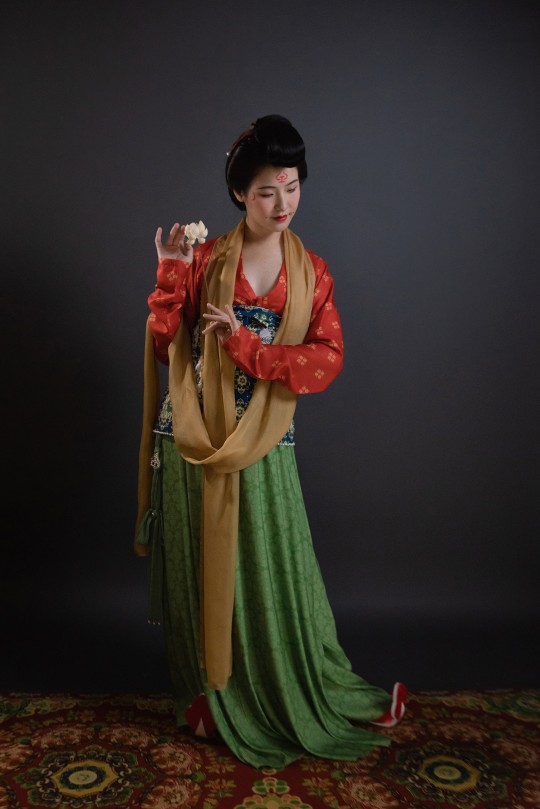
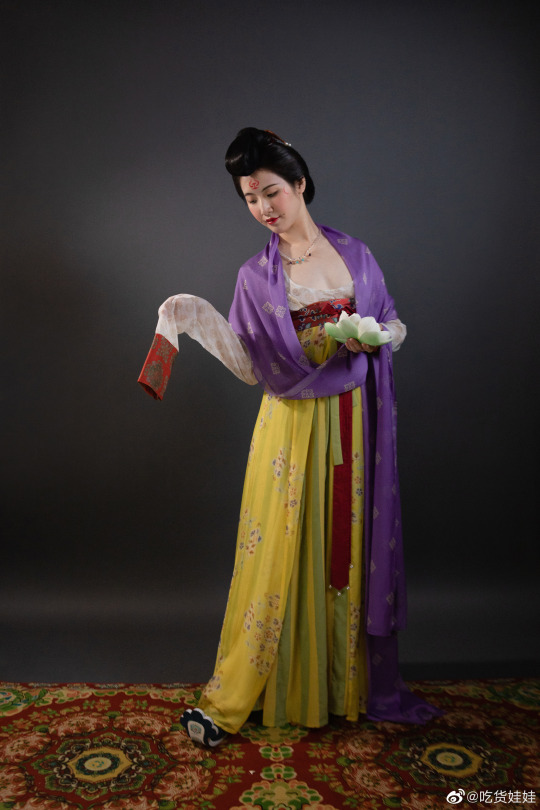
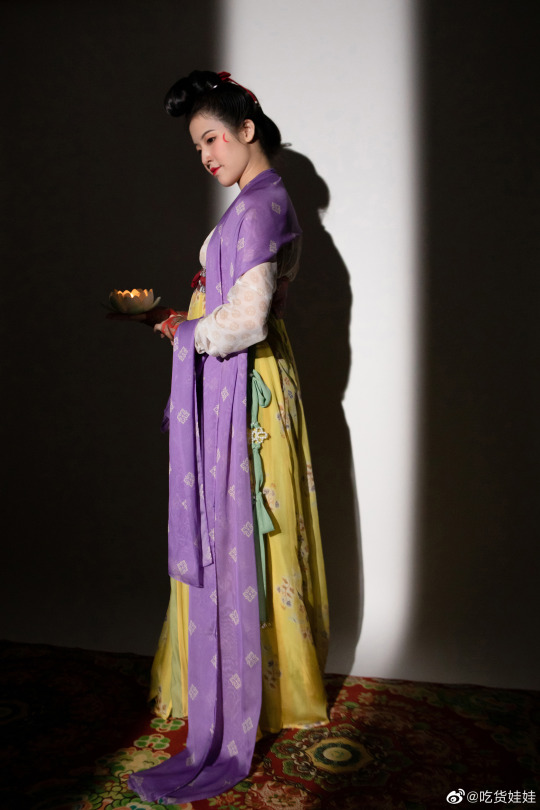
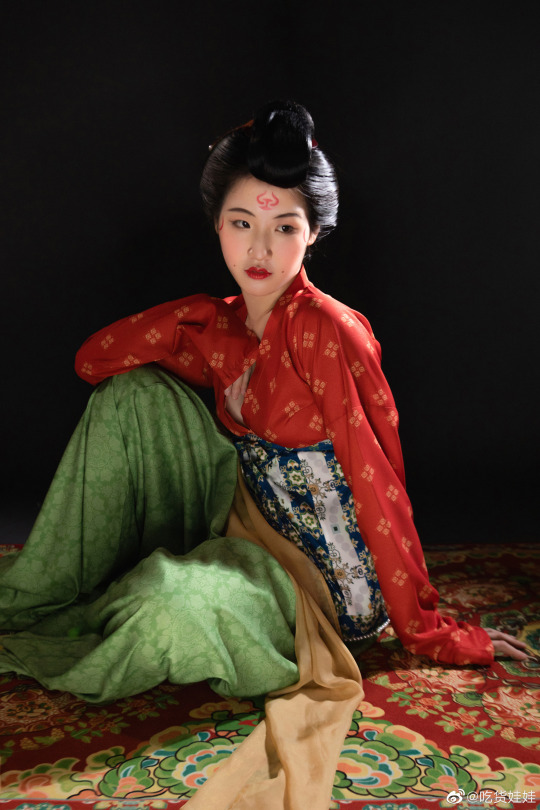
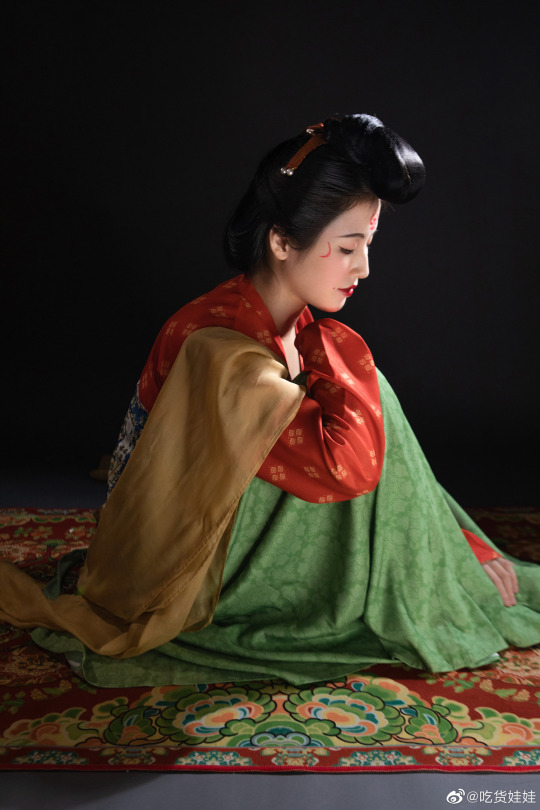


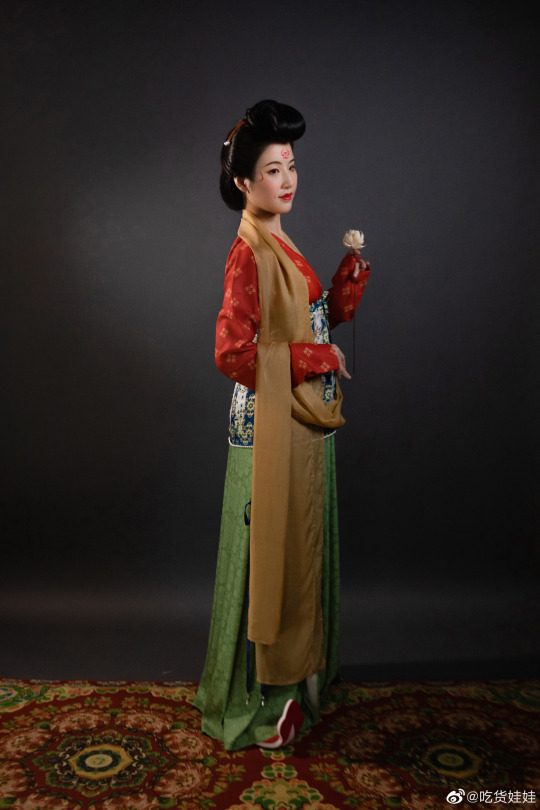
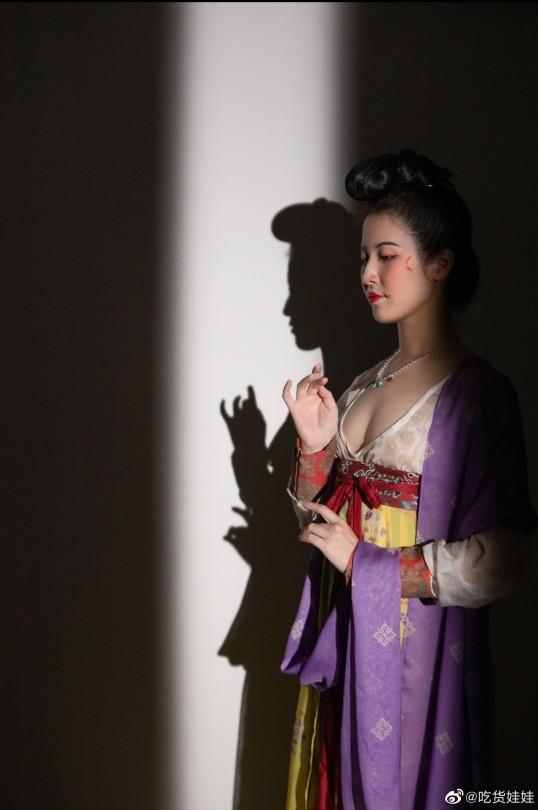
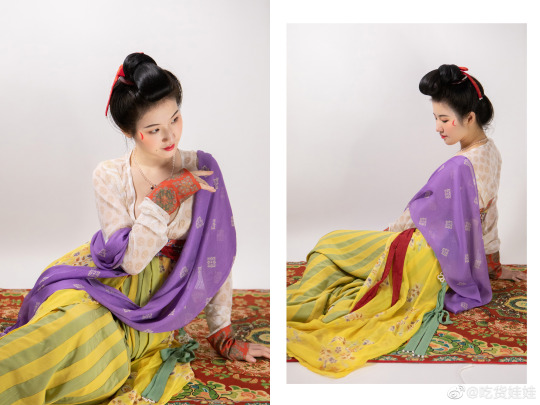
【Historical Reference Artifacts】:
Stone Carving from The Tomb of Xue Jing薛儆 (Emperor Ruizong's son-in-law) & Tang Dynasty Female Figurines:
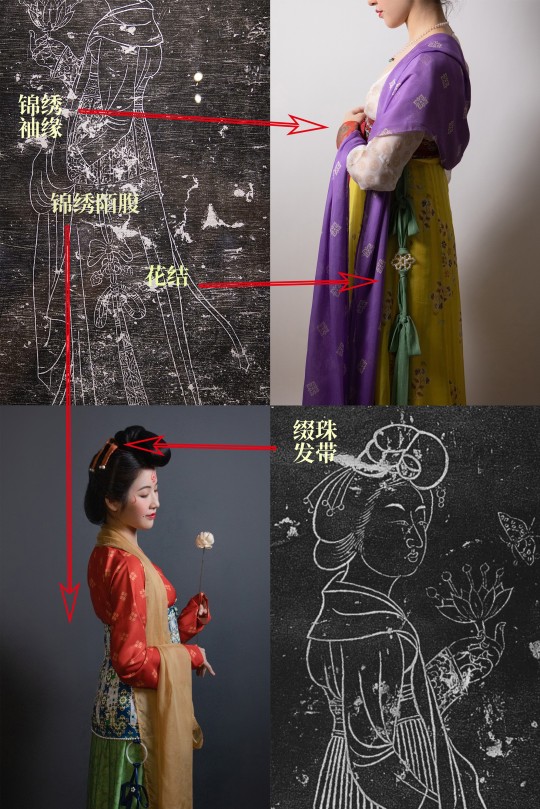



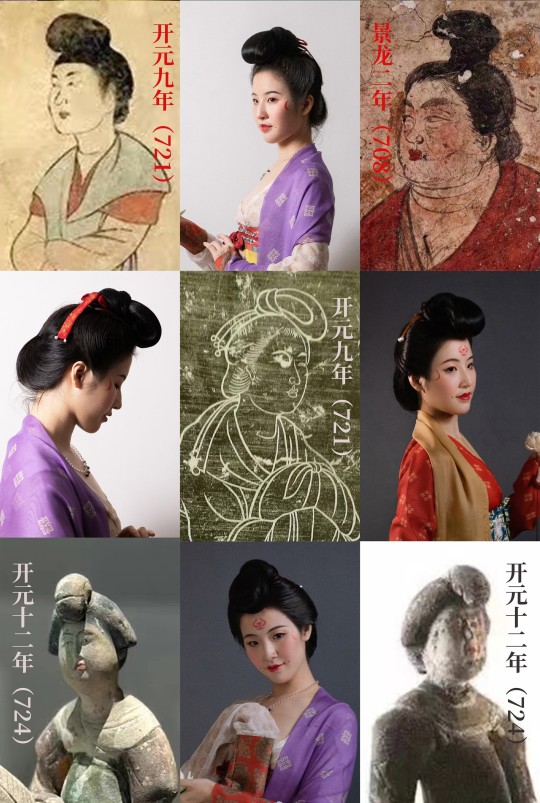

[Hanfu · 漢服]China Tang Dynasty (960–1127 AD) Chinese Traditional Clothing Hanfu & Hairstyle Based on Tang Dynasty Relics【沉寂千年的光阴】
Around the beginning of Kaiyuan period (708-724 AD) woman fashion & hairstyle
_______
Recreation Work :@吃货娃娃
🔗Weibo:https://weibo.com/1868003212/Mj46arcP9
_______
#Chinese Hanfu#Tang Dynasty (960–1127 AD)#beginning of Kaiyuan period (708-724 AD)#The Tomb of Xue Jing薛儆 (Emperor Ruizong's son-in-law)#锦绣袖缘#锦绣陌腹mofu#Huadian/花钿#裙背带#裙片掩合处#合围#背带#花结/flower knot#chinese traditional clothing#chinese historical fashion#Chinese Costume#chinese history#chinese archaeology#chinese culture relics#chinese art#Chinese Aesthetics#china#吃货娃娃#沉寂千年的光阴#hanfu#hanfu historical relic#hanfu history#漢服#汉服
223 notes
·
View notes
Text

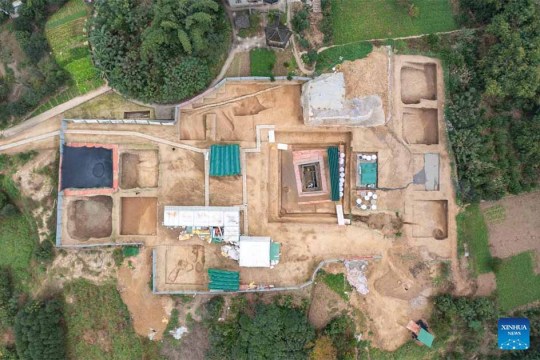
A Rare Western Han Dynasty Tomb Found in Southwest China
A well-preserved tomb, dating back to the Western Han Dynasty (202 BC-25 AD), with a clear recorded year has been discovered in Wulong District of southwest China's Chongqing Municipality, the Chongqing Cultural Relics and Archaeology Research Institute said Tuesday.
This archaeological project is a rescue excavation and protection work carried out to forge cooperation with the Baima project, the last of a cascade of hydropower stations on the section of the Wujiang River in Chongqing.
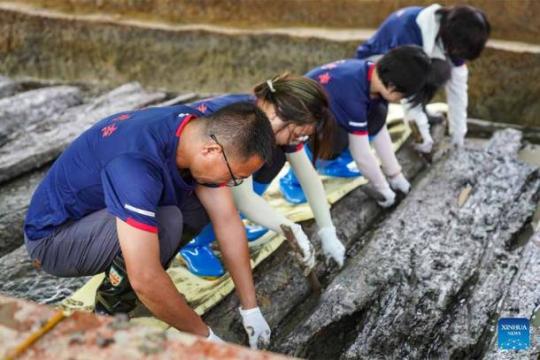

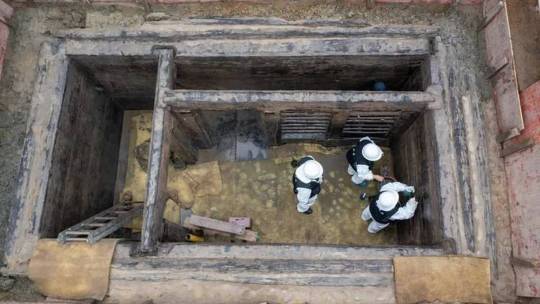

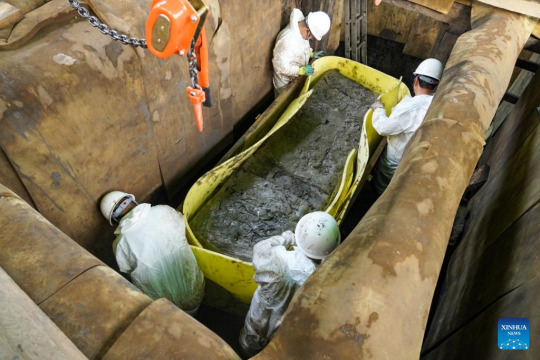

With the approval of the National Cultural Heritage Administration, the Chongqing Cultural Relics and Archaeology Research Institute set up a work team of more than 20 people from different archaeology research institutes and universities to excavate the site in March this year.
According to Huang Wei, the leader of the archaeological project, a collection of tombs dating from the Han Dynasty (202 BC-220 AD) to the Six Dynasties period (222-589) were newly discovered as part of this project. Among them, the tomb dating back to the Western Han Dynasty was the most important, and more than 600 precious cultural relics such as lacquerware, wood ware, bamboo ware, pottery and bronze ware were unearthed from the tomb.

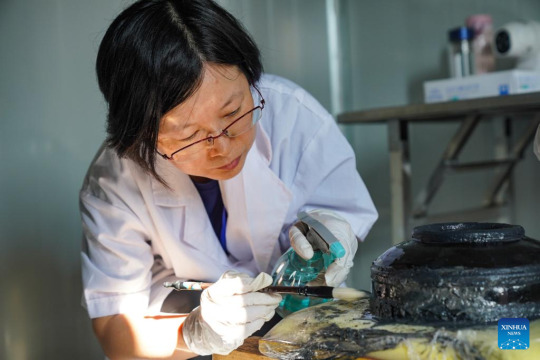
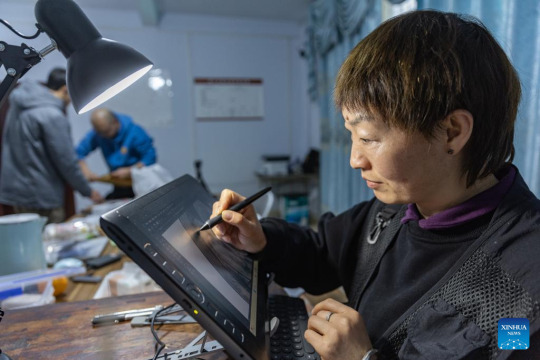
Due to the tomb being filled with water throughout the year, it remains undisturbed and unharmed, and the funerary objects in the tomb are well preserved.
"What is exciting about this discovery is not just the large number of unearthed artifacts but also the list of burial items containing a precise year record, which has been verified as 193 BC, providing clarity on the tomb's burial timeframe. An unearthed jade ware from the tomb shows the prominent position of the tomb owner," Huang said.
The list of burial items found in the tomb is complete and clearly records the name, quantity and size of the funerary objects.
The tomb discovered this time is the one containing the largest quantity of lacquered wood and bamboo wares ever found at one time in the upper reaches of the Yangtze River in China, said Bai Jiujiang, head of the Chongqing Cultural Relics and Archaeology Research Institute.

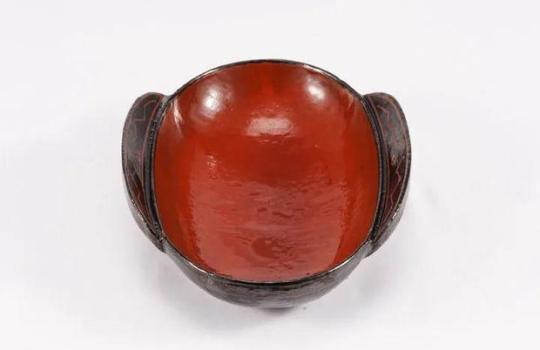

Based on publicly available information, it is also the earliest tomb of the Western Han Dynasty found in China, with a clear recorded year, according to Bai.
This is a major archaeological discovery regarding the Qin and Han Dynasties in the Wujiang River Basin, offering physical evidence and important basic research materials for future study of burial customs and the comparative analysis of famous artifacts from the early Western Han Dynasty, according to the archaeologists.
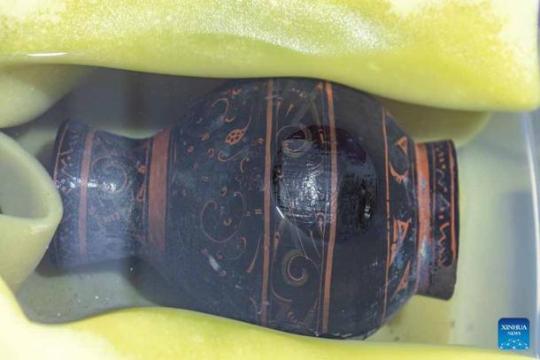

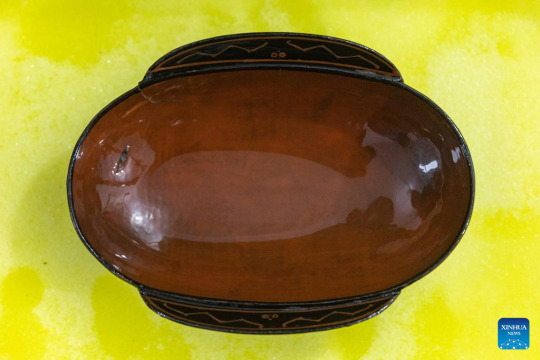

#A Rare Western Han Dynasty Tomb Found in Southwest China#Tomb Holding Hundreds of Ancient Relics Unearthed in China#Western Han Dynasty#ancient tomb#ancient grave#grave goods#ancient artifacts#archeology#archeolgst#history#history news#ancient history#ancient culture#ancient civilizations#ancient china#chinese history#chinese art
62 notes
·
View notes
Text
SANXINGDUI: A GLIMPSE INTO THE ENIGMATIC BRONZE AGE CIVILIZATION OF CHINA
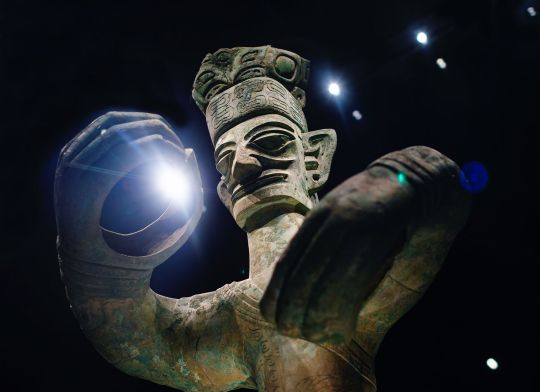
View On WordPress
#ancient China#archaeological discovery#archaeological research#Atlantis connection#Bronze Age#bronze casting#bronze masks#Chinese history#cultural center#extraterrestrial influence#gold relics#jade artifacts#lost civilization#political capital#ritual practices#Sanxingdui#Shanghai exhibition#Sichuan Province#Stars Over China#trade hub
1 note
·
View note
Text
I stumbled upon this article just now:
I honestly find the perspective presented here disgusting. There seems to be this notion that these are "artifacts," and that therefore their history is over. To the people who paint and repair them, they are just using them for their intended purpose, the way they were always used. They are just practicing their faith. If this had been done many years ago, as I am sure it has over the statue's centuries of existence, it would just be an example of "historical cultural and religious practices." But these people today are labeled uneducated and expected to let objects of their religion fall to ruin because they are "history" now.
When does something stop being what it is and become a relic of the past? Who decides when the past is over? One person's history is another person's present. I do not understand how the people who wrote this article managed to completely ignore this.
174 notes
·
View notes
Text
Terror Camp 2023's Panel Lineup Announcement is here!
We are so excited to hear from all of these amazing presenters over two days in December 🤩👏
Posters, artists alley tablers, and keynote speakers will be announced over the next few weeks, as well as the link to RSVP, so make sure you sign up for our mailing list on our website!
Without further ado:
Terror Day - Saturday, December 9
Panel A: Primary Sources
"old Harvey (a mulatto)": Sailors of Colour on British Arctic Expeditions (1848-1859), Edmund Wuyts
"Do attend to your orthography": spelling as history in Franklin Expedition Letters, Reg
Relic or Artefact; an Analysis of Polar Artefacts in Museum Catalogues, Ash
Panel B: Historical Persons
Thomas Holloway: Pills, Palaces, and The Accursed Bears, Verity Holloway
"Scarface" Charley Tong Sing: A Chinese-American on the Jeannette, In the Papers, and Afterwards, Han
Failsons of Hudson Bay, Jas Bevan Niss
“Nor will it yield to Norway or the Pole”: Roald Amundsen as Shakespearean Tragedy, Ireny
Panel C: Cultural Understandings and the Arctic
How Fares the Raft of the Medusa?: Mutiny, Cannibalism, and the Portrayal of History, Brianna Lou
“This Place Wants Us Dead”: The Terror and Folk Horror, Allison Raper
Icebound, Not Down, Hester Blum
Erebus Day - Sunday, December 10
Panel D: Death and Narratives of Death
"Known to all the youth of the Nation": Scott's Sacrifice in Children's Literature, Branwell
What We Talk About When We Talk About Quest, Caitlin Brandon
Funny to think of it as coming home: football, exploration, and the stories we tell ourselves, Rach
Panel E: The Allure of the Antarctic
From the South Pole to the Stars, Emma
The Feminine(?) Antarctic, Sam Botz
There and Back Again: In the Antarctic with Ross and Crozier, Phil Mikulski
Antarctic Roundtable
Out of the Rookery: An exploration of science and survival on Shackleton's Endurance, with Rebecca, Meg, and Avery
156 notes
·
View notes
Note
I read your tweet on how Wei Ying’s Guidao is orthodox cultivation based on real Guidao and that it’s descended from Bashu witchcraft. I’m very interested in that. Can you elaborate on it? What parts of WWX’s Guidao are based on real-life folklore? I’ve also seen people talk about how his cultivation is bad because it locks souls in their dead bodies. That doesn’t sound too credible to me, but I don’t know enough to be sure.
Hmm… I’m not sure what you want me to elaborate on exactly. It’s a lot of materials to cover. Dry materials at that.
In any case, Guidao 鬼道 (Path of the Dead, Ghost Path) is a real-life orthodox cultivation. WWX’s Ghost Path, aside from sharing the name, has two main aspects that draw directly from real-life basis: 1/ the summoning, nurturing, and utilizing of ghosts or wraiths (in the novel, those would be the ghost lady and the ghost child that killed Wang Lingjiao and Wen Zhuliu. In the Donghua, they are represented as ghost brides), and 2/ commanding fierce corpses.
These two aspects are drawn from two different sources.
I. Maoshan Sect’s Guidao:
As I mentioned in the tweet, the ghost path belongs to one of the three main fulu orthodox schools of Daoism: the Maoshan Sect (the other two being Quanzhen and Zhengyi)
The earliest mentions of Ghost Path are in Han and Jin history records as well as the Three Kingdoms: Zhang Lu biography texts. These texts talk of a Daoist named Zhang Lingzhi, whose Daoism is called Guidao 鬼道. Zhang Lingzhi taught the people the way of ghosts and dao and raised an army. His soldiers and generals were called ghost soldiers and ghost generals. Zhang Lingzhi’s Daoism was itself descended from Bashu ethnic group witchcraft. Zhang Lingzhi founded the 天师道 Tianshidao School.
(Citation: Sichuan Academy of Social Sciences - “巴蜀的“鬼道”如何变成了道教?” - How did Bashu’s ghost path become Taoism? http://www.sass.cn/912/default.aspx If you want to dig deeper, you can contact the academy directly for their research paper.)
Tianshidao School underwent several name changes over the year. To this day, they are known under the name (or descended, as some would say) Maoshan Sect in Jiangsu Province.
Maoshan sect has four major specialties: talisman, array, sorcery, and the nurturing of ghost familiars. After the cultural revolution, Maoshan sect lost a lot of its scriptures and relics. But it has been around for literally thousands of years. So there are still things there. It’s not the titan it used to be, but it’s still very much a cultural icon. There are numerous movies, books, and games that draw from Maoshan history and legends. One of them happens to be a movie cited as MXTX’s inspiration for aspects of MDZS in the recent Subaru magazine.

(Mr. Vampire, the movie cited in Subaru magazine features the adventure of a Maoshan Daoist)
II. Tujia 土家族 ethnic group’s stiff corpse driving sorcery - Hunan:
The other aspect of WWX’s ghost path: the commanding of dead corpses by a warlock. In the same Subaru interview, MXTX also talked of folk legends of Jiangshi (stiff corpse, or commonly translated as Chinese hopping vampire) serving as the basis for her fierce corpse, ranging from things like general abilities, toxicity, and tricks like using rice gruel to cure their poison.
Jiangshi has been around since the Ming dynasty, but tales of warlock with the ability to command them originate from the Tujia ethnic group in Hunan.
A jiangshi warlock process the corpses, plaster them with paper talismans to restrain their ferocity, tie them in a row, and leads them using a bell that the warlock continuously rings.
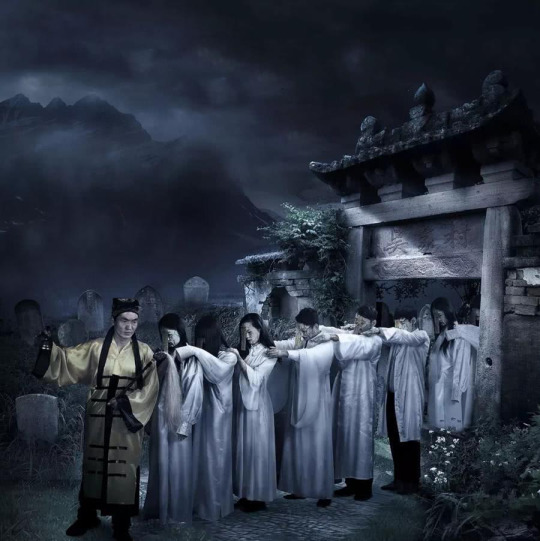
(Hoppy hoppy! It's edgiest conga train!)
Well, I don’t think I need to point out the similarity between the real-life Tujia warlock and WWX’s corpse commanding ability.
This specific sorcery was created in a time of war, when young men died in far-off lands. Their families, wanting to bury them in their home soil, would pay a warlock to go fetch their corpses and walk these corpses all the way back to their home province.
These legends might seem very fantastic but the corpse walking part is a very real job that still existed until the last 50 years. It’s featured in Liao Yiwu’s real-life journalism record “The Corpse Walker”
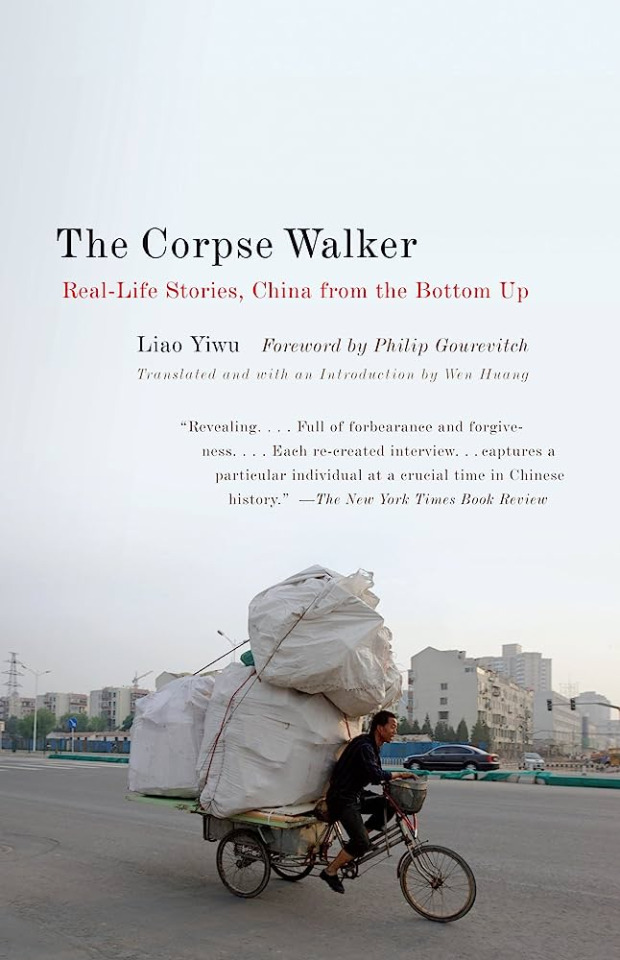
(It's a really thrilling read. I got the physical copy over 13 years ago while I was in my last year at university. I recommend it.)
III. How does Tujia warlock (and WWX) supposedly command corpses?
Regarding the whole, did WWX lock people’s souls inside their dead bodies. Uh…. I don’t think so.
Why?
Because Chinese beliefs about souls are different from Western beliefs. In Chinese lore, a person has three souls and seven spirits (三魂七魄). The three souls represent the positive aspects of a person, with one soul literally being a divine spark. The seven spirits represent earthly taints and degradations and are bound to the body. When a person dies, the three souls will go to the heavens, the next life, and the underworld, respectively. The seven spirits, on the other hand, dissipate after death after 49 days.
This belief is shared in other Sinosphere nations as well and is featured in other media franchises. If you read Inuyasha, you will remember the Jewel of Four Souls and the Four Souls concept being a close relative to three souls seven spirits. In Vietnam, there is folklore of Ba Hồn Bảy Vía and rituals on how to call a person's soul home.
It’s these seven spirits that create Jiangshi. If the spirits do not completely dissipate, the corpse turns into a Jiangshi, a literal life vampire that has only the worst aspect of the dead person and who is forever hungering for life energy. It is these seven spirits that a Tujia warlock (and WWX) controls.
When you have this context, you can put the creation of Wen Ning in a different perspective, and why is it that it's such a big deal he retains his consciousness as a corpse.
(Citation: https://baike.baidu.com/item/%E5%83%B5%E5%B0%B8/80733
184 notes
·
View notes
Text



wip...
Chinese Tang Dynasty style hair
PS.
Picture 3 is a pottery figurine cultural relic from the Tang Dynasty in China.
Era: Tang Dynasty (618~907)
Category: Pottery
Texture: pottery
Dimensions: Height 45.9 cm
Collectionunit: Xi'an Museum
41 notes
·
View notes
Text
Why didn't they make the new Indiana Jones movie be about Indy handing over the reins to a now adult Short Round instead?
I would 10000% watch a "Adult Short Round navigating both looking for artifacts in ancient ruins and ALSO navigating racism and prejudice from American museum owners and such while still being the tiny bastard fuck personality he had in Temple of Doom"
Get Ke Huy Quan in here! It could have been SO interesting and with many smaller themes and concepts in there! The first and 2nd Indiana Jones was already about Indy punching nazis! Have there be some or other through line about stuffy Museum owners in the 1950s have to deal with a Chinese man who is better at relic hunting than ANY of them have ever been and who also used to be Indiana Jones' getaway driver when he was 8. A mix of hyper intelligent, refined but also bastard-man energy!
THE STORY ALMOST WRITES ITSELF!
And don't do the whole "This is the Han Solo Movie" where it just exists to shoutout callbacks to the original Star Wars Trilogy. Actually ENGAGE with a story about a well educated through practice not schooling man be one of a dying breed of relic hunters who truly cares about history and the preservation of ancient cultures! Bring in that Post WW2 tension and bizarre global mental state!
Why didn't they just give us a Short Round movie and actually put effort into it????
#text post#sorry I just realised the other day we could have had a Short Round movie with Ke Huy Quan and got very angry#Somebody draw this
28 notes
·
View notes
Text
AS THEY SHOULD.
I'm not a huge fan of China or anything but it really says something about British Colonialism that China has a point here
-fae
66 notes
·
View notes
Text
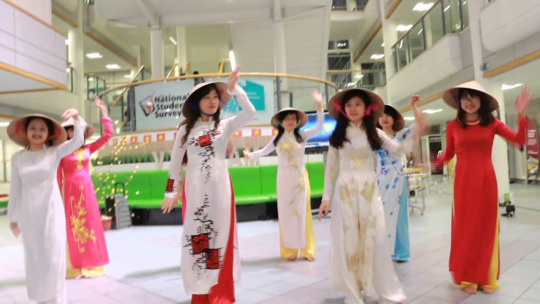
Vietnamese Cultural Dances
Dong Son Drums, relics from the Red River Delta which date all the way back to 600 BCE, are carved with dancing figures; That is how integral dancing has been to Vietnamese culture. The dominant kinh ethnicity in Vietnam have developed a variety of dance forms over the centuries, apart from the traditional dances each of the 54 minority groups in Vietnam has. All of these have given rise to a vibrant performance culture in Vietnam, characterized by extravagant costumes, heavy make-up and Nhã Nhac ('elegant' music of the Imperial Court) tunes. Traditional Vietnamese dance can be classified as:
1. Dragon/Lion Dance

The Lion Dance, one of the most popular traditional dances in Vietnam
The yellow and red dragon is a well-known Chinese motif that signifies power and good fortune. It has been tweaked and adapted into Vietnamese culture, and is a common sight on Vietnamese festivals such as Tet (The Vietnamese New Year) and the Mid-Autumn festival as well as events like business openings. It is usually accompanied by acrobatics and martial arts and creates an atmosphere of festive merry-making.
2. Fan Dance

Fan Dance or Vu Phien, a Traditional Vietnamese Dance gaining popularity in Southeast Asia
As the name suggests, 4 or 5 dancers dance with beautiful fans are a part of the fan dance, which is believed to have originated in meadows and open fields. The fan dance is meant to delight the audience while the dancers imitate flowers gliding gently on the breeze, which makes this a unique art form that is fast gaining popularity in neighbouring countries such as China and Korea.
3. Hat Dance

Performance of the Hat Dance in Vietnam
The hat dance, like the fan dance, is another incredible cultural dance in Vietnam that breathes synchronicity. Hat dancers twirl around gracefully while they exchange and manoeuvre their large bamboo hats, a homage to the farmers who work hard in the fields and provide grain. The dance usually ends with the dancers inviting volunteers to participate with them on the stage, so that the show ends on a memorable note.
4. Lantern Dance

The Lantern Dance, a Traditional Dance of Vietnam with Buddhist Roots
This one is a visual delight. Dancers hold and glide in between lanterns, which sometimes surround idols or statues. It is performed on New Years and is a favourite of children. After the performance, the dancers let go of their lanterns which float towards the sky together with balloons and fireworks to create a stunning night scene.
13 notes
·
View notes
Photo
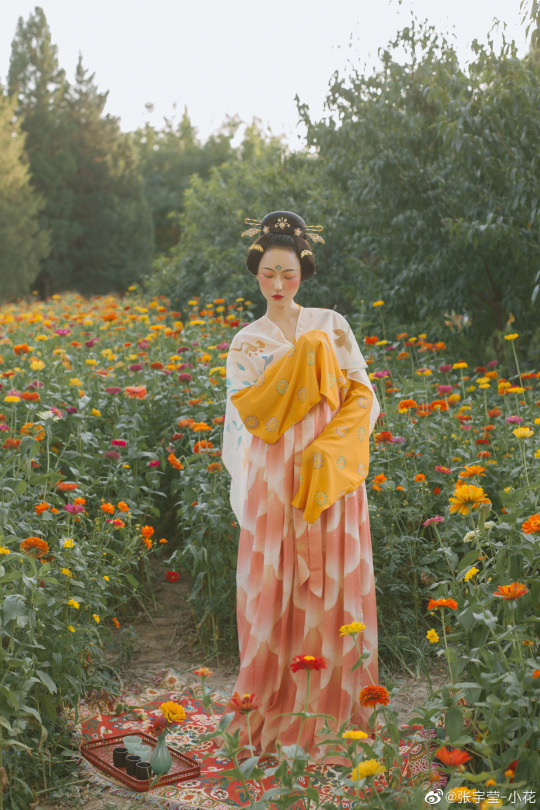
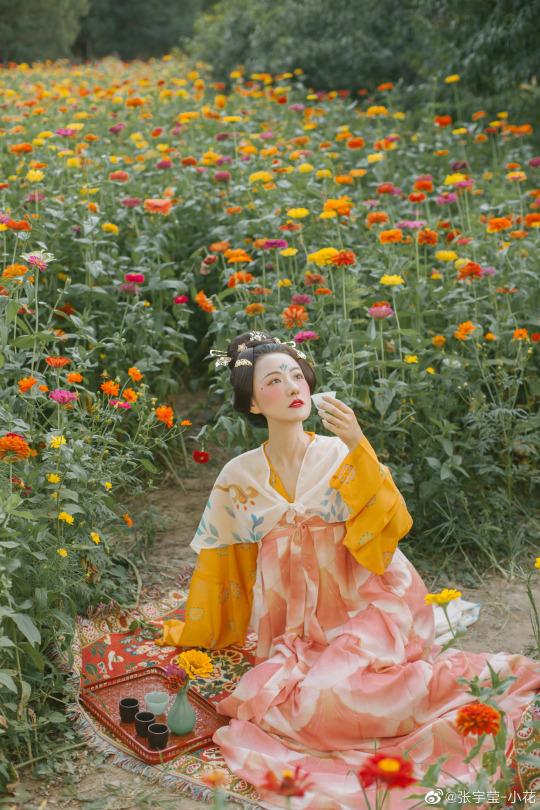


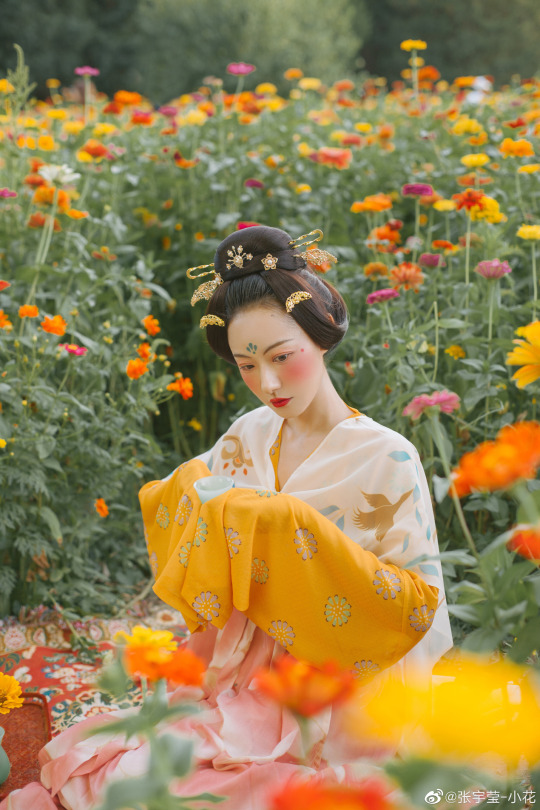
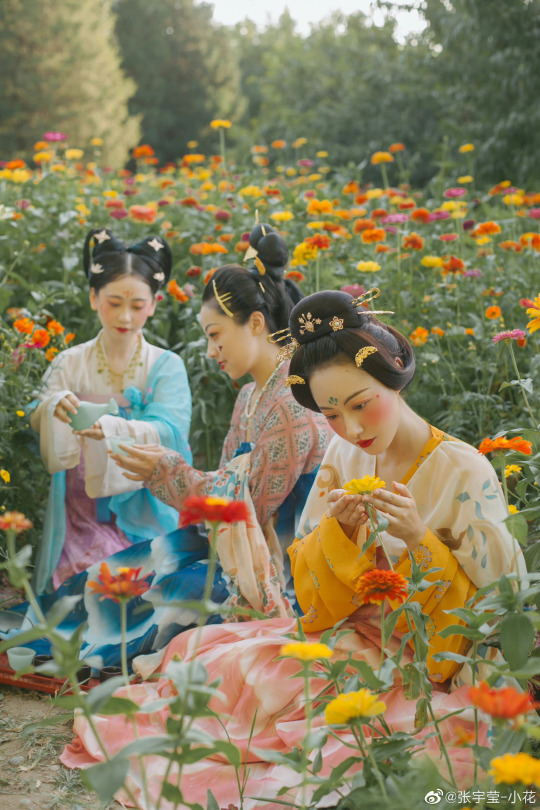
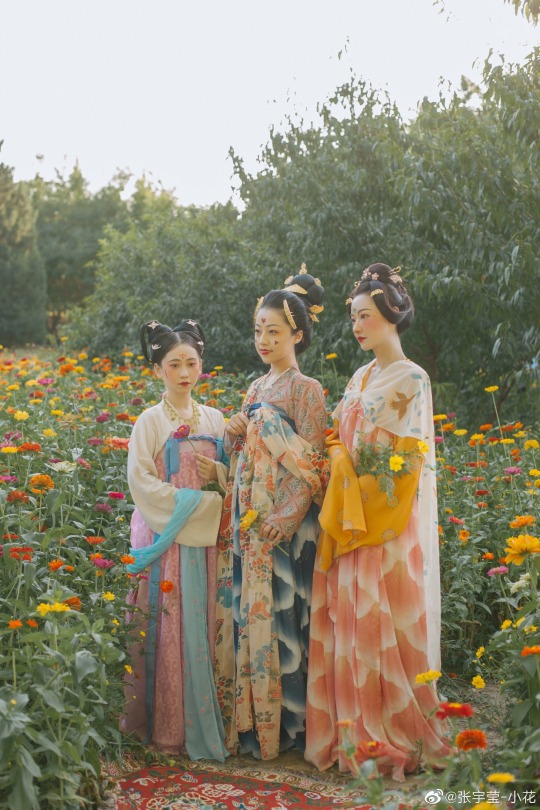



[Hanfu · 漢服]China Tang Dynasty Chinese Traditional Clothing Hanfu Photoshoots-【姹紫嫣红的秋天与绚烂的大唐色彩 】
_______
📸Photo: @摄影师梁咩咩
👗Hanfu: @佳期阁 @嵠上 @花朝记
🧚🏻 Model: @国风金小鱼, @茶瓶儿ya, @张宇莹-小花
🔗Weibo:https://weibo.com/1937611335/MbPCRptoE
_______
#chinese hanfu#hanfu#Tang Dynasty#hanfu accessories#hanfu art#hanfu_challenge#chinese culture relics#chinese fashion#chinese style#Chinese Costume#chinese traditional clothing#chinese historical fashion#ruqu#pibo#huadian#摄影师梁咩咩#佳期阁#嵠上#花朝记#国风金小鱼#茶瓶儿ya#张宇莹-小花#漢服#汉服
242 notes
·
View notes
Text

Grave Robber Looted 2,400-Year-Old Tomb in China — But Left Treasures Behind
In a cemetery in central China, a grave robber started to dig. The thief tunneled into an ancient tomb, stole some artifacts and vanished. The robbery, however, was only partially successful.
When archaeologists excavated the looted tomb, they realized the robber had left some rare treasures behind.
The Taosi Relic Site and Cemetery is a massive ancient cemetery in Shanxi Province that may have as many as 10,000 tombs, according to a 2018 news release from China Archaeology Network. Excavations of the cemetery have been ongoing for years, but archaeologists have only explored a fraction of the site.
During these excavations, archaeologists uncovered a 2,400-year-old tomb that had been looted by a grave robber, according to a Jan. 21 news release from CCTV News via the Institute of Archaeology at the Chinese Academy of Social Sciences and the China Archaeology Network.




The robber had entered the tomb in 2016 through a hole in one corner, the institute said. The thief stole artifacts from this corner but left most of the grave undisturbed.
Archaeologists unearthed a large number of high-quality artifacts from the 2,400-year-old tomb. They found a set of 16 chimes engraved with sayings, weapons and jade artifacts.
A photo shows some of the ancient musical instruments found in the tomb.
The tomb also contained a bronze drum base, archaeologists said. The base has a hollow shape where a drum would be inserted. Measuring about 33 inches across, the newly found base is among the largest of these types of artifacts ever found in China.
Based on the artifacts found in the 2,400-year-old tomb, archaeologists believe the tomb belongs to a high-ranking aristocrat with significant power.
Officials recovered some bronze artifacts stolen from the Taosi Cemetery in 2022, the institute said.
Taosi Relic Site and Cemetery is in Shanxi Province and about 250 miles southwest of Beijing.
By Aspen Pflughoeft.


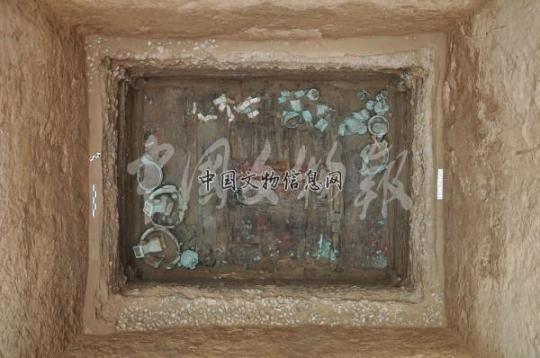
#Grave Robber Looted 2400-Year-Old Tomb in China — But Left Treasures Behind#The Taosi Relic Site and Cemetery#Shanxi Province#ancient grave#ancient tomb#ancient artifacts#archeology#archeolgst#history#history news#ancient history#ancient culture#ancient civilizations#ancient china#chinese history#chinese art
32 notes
·
View notes
Note
How would the German Brothers, France, England, Russia, and China react to their American s/o (who recently moved countries to move in with them) dealing with extreme homesickness?
German Brothers + Allies with a homesick S/O
(I made this for a S/O from anywhere in the world since America already lives there and he must be included. Everyone loves that greasy bomber jacket blonde lol)
German Brothers:
Germany:
He understands what homesickness feels like. Between the wars from the past, and the meetings for the future he usually upholds, he is rarely at his nice clean home.
He does his best to console them, and buys them stuff from their home country.
One day he was talking with Italy, and was shocked when Italy suggested to just have more meetings in their home country and bring them with when they start to miss it.
He starts to do just that.
Makes extra time to take them to nice resturants or their hometown and to visit as much of their family and friends as possible.
He realizes having them as a traveling companion helped his stress levels so now they're his emotional support S/O!
Now at least when they miss their home, they won't be alone in that.
Prussia:
Man is retired, and LOVES to travel and learn stuff.
Has no problem sneaking his S/O away to their country.
Movie nights with subtitles will happen frequently. He's not even paying attention he's just so happy his Jewel is happy.
Also cooks a lot of food from their homelands as well as gifts and tacky tourist gages just to make them smile.
Allies:
America:
Doesn't fully understand at first since he couldn't WAIT to break free from England.
Doesn't stop him from bringing his S/O to all the themed resturants in America.
Even has pinned down all the cultural museum spots from their Homeland.
Has an endless knowledge about S/O's heritage of cryptic and ghouls.
Loves seeing them happy and will fly them out, even if he can't go with due to restrictions.
Will help make an album of photos and magazines and newspapers and all that good stuff with them.
Also expect a LOT of imported snacks from their home country as well.
England:
We will pretend he thinks museums don't exist, and that his country doesn't have any major art works.
This will be the ONLY time it's a good thing because now his S/O can ramble off what all the foreign words are.
Laughs when he learns the British museums didn't realize a relic was NOT in fact used to make biscuits.
He won't be able to go with them, but sends a friend of theirs to go with and gives them an allowance to go on a shopping spree and eat at the highest quality of resturants/food markets.
Bring him back a teacup, or pottery piece and he will fight tears over the fact they thought of him just as much as he did of them.
France:
HUGE advocate for getting to travel with his S/O.
Unless there's a riot outside his window he will drop everything to go.
"It would be unfair to give up your life completely just for me, non?"
Showers them with romantic evenings and maybe a get together with friends and family.
France has an amazing wifi connection so he will set up a place to video chat with their friends.
After all even just friends can bring you back home.
Will have random people send postcards so his S/O can make a picture map of their countries best sight seeing places.
Even if he does most the work.
China
He's not too keen on traveling there, and rarely let's his S/O go back
But when they do its not a small trip. We're talking a couple months, or until they had enough.
He will try his best to incorporate foods from the other country and enjoys the process.
He has also shipped out many books and movies to China for them.
Though he will evidently receive chinese rip offs, and gets agitated and apologetic.
He knows it's an issue, they guy is trying his hardest!
Russia
He gets a little sad, thinking they just don't want to be with him.
Even so that in itself is understandable, but decides to go on a trip with them anyway.
Look out if it's a nice and sunny beach like country (or has any beaches regardless)
He will become a very happy sunburnt Russian. Sunscreen? What's that?
His S/O will have to fight with him ti actually go back home because how their home is him new home, da?
Have fun with your summer stays!
#hetalia#hws#aph#hetalia russia#hetalia china#hetalia france#hetalia england#hetalia american#hetalia germany#hetalia prussia
7 notes
·
View notes
Text
A Dinoverse Creation Myth
(in three parts)
before we start - I am highly aware that what I put below is largely irrelevant to the "present day" stories of the Dinoverse games. however, though most of it was pulled out of the ass, at its very foundation the following is based on one-off mentions of what is likely a mythos for the world that the games take place in, despite it otherwise being very much sci-fi with no fantasy to speak of... perhaps a relic of a bygone era of superstition?
and if you know me, I am an enthusiast when it comes to mythology, from both real cultures and fictional worlds - though tenuous, I did notice some parallels in the excerpts from the games and a certain creation myth from real life - uncannily matching in what is literally stated in the first part, and while not as literal with the third part has some corresponding themes about the nature of humanity and destiny. both of these are from Phantom Of The G4, the translation of which you can read HERE (specifically at the bottom of page 4, and the middle of page 10).
(note: one day I might attempt my own translation, as Chinese is my second language since childhood)
the second part, meanwhile, is directly explained in VTSOM's chapter 4... albeit referencing real life a little too much. now this is probably intentional if VTSOM is set in a future Earth, but I doubt it (I mean, I can't find anywhere the g-districts match up with geographically)... and besides, it takes away all the fun of making up new lore! anyways, HERE is a chapter 4 playthrough (spoilers naturally abounding) with the timestamp where this piece of lore is discussed.
anyway, enough rambling, let's get to the proper writing I did...
I
In the beginning, there was simply a vast nothingness.
From this nothingness were born the light and the dark, still diffuse; it took many aeons for the light and the dark to coalesce, and become encased in an egg.
And it was from within this egg that the Great God awoke, with a honed blade in hand.
He sliced a boundary between the light and the dark, to create the heavens and the earth, and stood in the gap between to fully separate them.
But still the world was an empty one, and the Great God knew that the only way to fill it was to use his own body.
And so, facing the light, with his back to the dark, he abandoned his body to become a spirit that moved across the heavens.
The place upon which he died became the Mount Arrat, where others after him shall ascend the same way.
His bones became the rocks, and his marrow, precious ore; his flesh, the soil, and his hair, the plants; his blood, the rivers and seas; his left eye the sun, and his right eye the moon, still and forever keeping watch upon the world in both the light and the dark.
II
From his remains, the spirit of the Great God could will new life, populating the land, and the seas, and the air with living creatures of all shapes and sizes.
Among them was the great sea-serpent Liveiataan, or Leviathan; and she had become powerful and fearsome, with teeth like swords and eyes like the dawn.
Her power and her ferocity made the spirit of the Great God wary, for it was only meant to be him who could create, and bestow, and change, and remove, and destroy.
And with her heart like unbreakable stone, and her mouth that could not be shut by any force, Liveiataan did not submit to his will.
Thus, the spirit of Great God took his sword and slew Liveiataan, and from her dead-flesh also willed new life; from it came gods shaped like men, but with the tails of serpents.
And the spirit of the Great God found it good that these were now under his control.
III
Among the gods born from Liveiataan's remains was the Serpent Woman; while her brothers took to the heavens, she remained on the earth, and grew lonely.
Thus the Serpent Woman pleaded with the spirit of the Great God for companionship, which he understood, and gave her permission to create new life.
From clay and fertile earth she molded the first humans, and showed these to the spirit of the Great God, who found her creations worthy to rule the world.
From the heavens he called down the Serpent Woman’s twin, the Bright One, who taught the humans to hunt, fish, and tame the other living creatures whose world they now lived in.
Though the Serpent Woman wished to create even more humans, the way she had previously made them was far too difficult, too time-consuming, and drained her of her power.
And so she found a simpler method, by dragging a cord through the mud; and while this produced many humans, their quality was mediocre compared to those she had molded with her hands.
And neither the spirit of the Great God nor the Bright One favoured these humans, who had to be taught by their predecessors.
Thus, the people born from the mud, of which there is a great abundance, are forever destined to be inadequate, unable to ascend Arrat and join the gods; and the people shaped by the Serpent Woman’s hand and taught by the Bright One destined to lead and illuminate the path to the future.
now, an explanation of the inspirations for this story - as well as some extra thoughts not included in the story itself, left out for others to figure out later.
this tale is largely based on Chinese mythology - elements of which seem to show up elsewhere in the Dinoverse, possibly because Dino themselves are Chinese, and that I will touch on another time because of how fascinating mythological motifs are to me.
the Great God is based on the creator deity Pangu, who just like the "god" mentioned in POTG4 created the world from various parts of his body, down to the sun and moon being his eyes. however, instead of an axe, his weapon of choice is a sword as per his description in VTSOM.
the Serpent Woman was more or less original on my part, and based on the goddess Nüwa, creator of humans using different methods for nobles and commoners (which parallels the "some souls forever destined to be inadequate" thing in POTG4); and the Bright One likewise, based on her brother Fuxi. (it seems that for many of these ancient Chinese gods, their mark of divinity was having a serpentine tail/lower body, hence the Serpent Woman's other, unnamed brothers, who may be significant in another story.)
and while Liveiataan bears some resemblance in role to the aforementioned twin deities' parent Huaxu, she is based more on the Near-Eastern Leviathan as well as its forerunners Lotan, Tamtum, and especially Tiamat, who some have noted similarities with both Pangu and Nüwa. the odd spelling of "Liveiataan" is intentional, by the way, to avoid confusion with the real-world Leviathan.
speaking of Liveiataan - in-universe she is described as "a symbol of power, and perfect government" fitting as she was the only creature powerful enough to pose a threat to the Great God. Myers was certainly onto something to have a poster of her in their basement, doubly-so one with the image of the Great God cropped out, as Vincent discusses how they wish to achieve godhood and create a new world order.
interestingly, they do this with their cyborgs, and to create such, they infuse the bodies of the worthy - the ones created by the Serpent Woman - with (presumably?) metal - the refined bone-marrow of the Great God, if we are going by the myth...
now again, this is all p much pulled out of the ass and written at around 3am of last night, so forgive me if it is all very unhinged. but I had fun writing and analysing, and would like to hear thoughts.
7 notes
·
View notes
Text
Hanfu movement is about MODERN ethnic clothing. What is the authentic “han” clothing? Who is going to decide for everyone? There are millions of Chinese around the world. Who could say something and everyone would follow? You? Me? The China government? Come on the moment China government said something it will be on the news that a totalitarian regime is mandating how people should dress.
Korean, Japan, Vietnam and England did not have such a tragic discontinuation of wearing their style when they all have their “modernization” period of pain. Also, have you considered the amount of Chinese involved in the situation? Also the geographical differences, the culture background and the resulted fashion preference of those people? Having only one (1) style of clothing actually is not the norm. Like the Dai people could have very different clothing depending on their villages. And the related Thai women in Thailand have at least... 7 different blouses? And those are modern invention too. Less than 100 years.
I live in a country where wearing traditional clothing, at least for women (pretty sure this is a relic from the colonialism period - men wore the European clothes while the women wore the ethnic clothes to show “fusion”, “respect” etc.), is very normal, even for work. For example, Indians. What is the traditional clothing of an Indian woman? A sari, you may say. But in my experience, most people don’t wear sari to work. I asked my teacher why. She said she did not like showing the waist. I only had one colleague who regularly wears Sari to work. But she is also a priest. Also I am quite sure that she only wears Sari when she is going to the temple on that day. What does the other wear usually? Usually they wear a tunic plus a trousers. There are many many many different types of tunic and I did not follow them. Each type of tunic are most likely came from different region (so the bottom to match is actually slightly different, but again, I did not follow). I remember back in high school, once they showed about 20 different types of Indian clothing, each from different regions, or different kingdoms historically. And that was put together by one (1) schoolmate. I am sure there is much more variants in Indian traditional clothing.
In addition, clothing from each dynasty reflected their characteristics. And modern Chinese needs something that reflect them. So why stick to a dynasty when you have so many to chose from? Looking back at different periods of time was also what people did back in the days (Ming dynasty), but they did not have the technology nor the archeological discoveries that we can access nowadays. Also people from different regions have different needs. Certain styles would be more prominent in certain regions. And those not suitable for people will fall into disuse. Like, quju was rather popular a decade ago, but only a handful of people are into it now, because the construction of the clothing does not match modern needs.
So forming a modern Han clothing is still an ongoing process. It has only been, like, 20 years? It takes time to come to a conscious. Many people just started to wear hanfu recently. It takes time to build up their taste and wardrobe. Historically, it took a few decades for Ming dynasty to settle into their own style. Chill. People will come to a conclusion. Give them time. Give yourself time.
If one don’t want to sit it up one could always wear the cheongsam. Even then there are so many different cuts to choose from. XP There is also non-cheongsam Chinese traditional clothing but people probably don’t recognize them and only really old grannies wear them nowadays. And most of them switched to buttons, at least in my region.
On the other hand, please consider cultivating your own social experience. And only hang out with friends or circles that decided on the style you also liked. I know there are people who are firmly focus on late late Ming style. There are also a lot of events and gatherings that are style-limited. YOU CAN MAKE YOUR OWN CALL. Don’t let the others decide for you. If you wear hanfu, you are one of the movement. Development your own circle if you like certain style. Consider becoming an influencer if you want people to follow your way. (Also, some people are only in for the money and know no shit about hanfu. So beware.)
Lastly, the online filter bubble is actually very strong if one picks the right people to follow. Like, a couple months ago I asked my friend what did she think about the fashion trend this year because I couldn’t see one. She said, definitely heziqun, especially for the newbies. For me, I have seen nearly zero news and updates on heziqun since Qinghuige time because I only followed a selection of people and bots on weibo. Since anyone wearing hanfu as daily wear for a few years knew heziqun is a recent invention (less than 3 years) as the whole structure is ridiculous and tedious to wear, so heziqun isn’t something those people would consider. Therefore I don’t see them on my dash. There were a couple of beidaiqun. Meh. Tang style is a wild place. Don’t go into Tang style if you want 100% historical accurate style. Or don’t even go into general hanfu fashion but only follow that handful of research and reconstruction blogs.
TLDR: There is no one that has the authenticity in Hanfu Movement to decide what specific style people should stick to. Make your own decision and hang out with people of like mind if you don’t want to see a variation of styles appearing in one place.
#hanfu#rants#long post#either be proactive or just go with the flow#like if you are the host you can decide the theme#otherwise you can't decide what the other guests would wear#well i am sure you can gossips with your friends#but you can't go up to a stranger and tell them they should wear not this but that
183 notes
·
View notes
Note
hello everyone, i'm Sparrow over on patreon, LOVING the work you guys are doing!! :D
i've been meaning to ask, do you have any of the sources you guys used when doing the short timeline about Nezha and Heavenly King Li on Production Notes #4? Me and a friend are looking into the evolution of Nalakubara, and maybe those can help us! (it's okay if they aren't in English)
Thanks for the question!
Our main reference for this part of the script is a video by Professor Yu Gengzhe from Shaanxi Normal University which he mainly talked about the origin of the mythical character Li Jing and he naturally brought up Ne Zha towards the end.
【鉴定42】唐朝战神李靖是如何托上塔的?哪吒他爹居然是这么诞生的!_哔哩哔哩_bilibili
He's one of my favorite historians (watched all his CCTV lectures, bought his books etc) and Sui/Tang Dynasty is very much his expertise. In the video, he provided several written sources that trace the evolution of the figures, plus some physical relics as evidence. Hope they can be helpful for your research.
His videos are aimed at the general public so they are easy to understand and doesn't burden you with too much academic details. Our production notes are produced on a similar principle, assuming that our audience has little to no knowledge of Chinese culture. So for a lot of topics, we simply touch the surface and don't dig too deep. Which is why you are always welcome to let us know if you want to move further on the topics!
10 notes
·
View notes